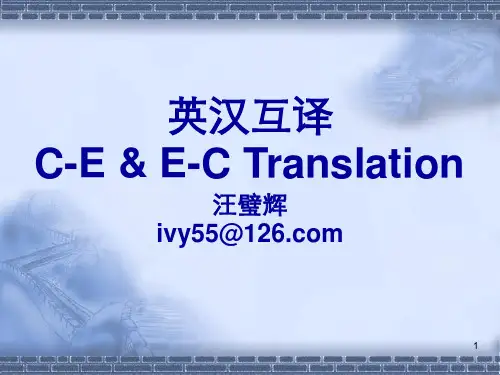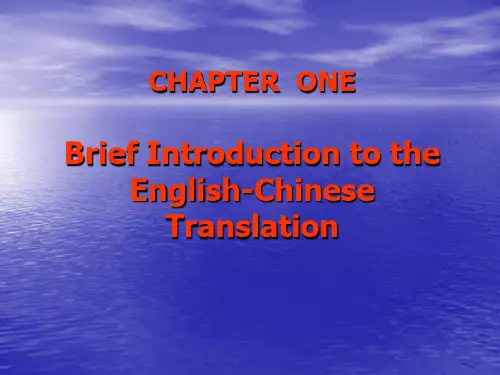E-C translation 第一章 翻译概述
- 格式:ppt
- 大小:575.50 KB
- 文档页数:16
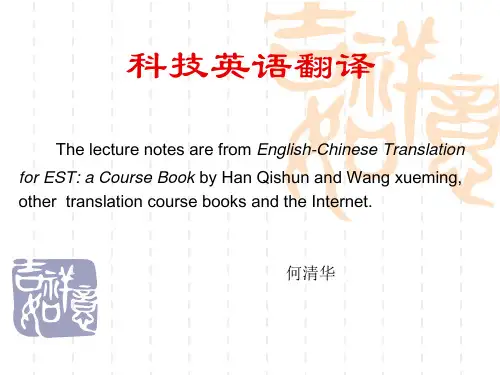
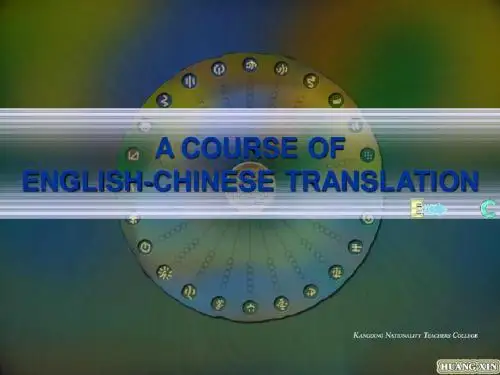
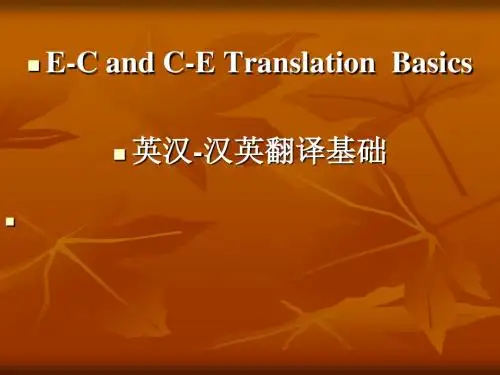

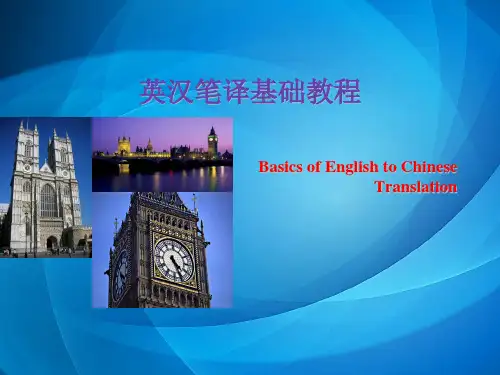
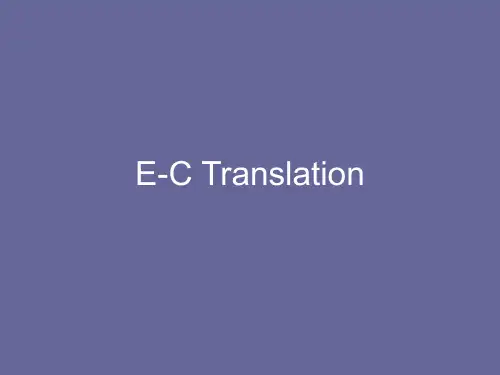

换言之翻译第一章讲义西外In Other Words:A Coursebook on TranslationMona BakerAn Egyptian professor of translation studiesat the University of Manchester in England,and an editor of "The Translator" andeditorial director of St. Jerome Publishing.She first arrived at UMIST (The University of Manchester Institute of Science and Technology) in 1995 and became a professor there in 1997. She provides commentary on the Middle East conflict, and research in translation and intercultural studies. The site also has sections on the boycott of Israeli academic institutions, Israel and Palestinian universities, general opinions on the Middle East and calls for boycott of Israeli products and services.ScheduleWeek 1 Chapter1+2Week 2 3+4Week 3 5Week 4 6Week 5 7Each Week: Theory 2 hours + Practice 1 hourTERMINOLOGYBack translationWordMorphemeLexical meaningPropositional meaningExpressive meaningPresupposed meaningSelectional restrictionCollocational restrictionEvoked meaningDialectRegisterFieldTenorModeSemantic fieldLexical setsSuperordinateHyponymLoan wordFalse friendBack translation: a process in which a text that has been translated into a given language is retranslated into the source language. P8Word: the smallest unit of language that can be used by itself. P11Morpheme: the minimal formal element of meaning in language; a unit which cannot contain morethan one element of meaning and cannot be further analyzed. P11Lexical meaning: the specific value a word has in a particular linguistic system and the “personality”it acquires through usage within that system. P12Propositional meaning: the meaning of a word or an utterance which arises from the relation between it and what itrefers to or describes in a real or imaginary world, as conceived by the speakers of the particular language to which the word or utterance belongs. P13Expressive meaning: the meaning of a word or an utterance which relates to the speaker?s feelings or attitude rather than to what words and utterances refer to. P13Presupposed meaning: the meaning of a word or an utterance which arises from co-occurrence restrictions, i.e. restrictions on what other words or expressions we expect to see before or after a particular lexical unit. P14Selectional restriction: 1. a restriction on the choice of individual lexical units in construction with other lexical units. E.g. breath will typically “select” an animate subject, not an abstract or an inanimate. 2. A restriction imposed on the potential referents of a phrase, etc. related to it: e.g. pregnant will typically “select” a subject referring to someone or some animal that is female. P14 Collocational restriction: any restriction on the collocability of one individual word with another. P14 Evoked meaning: the meaning which arises from dialect and register variation. P15Dialect: A dialect is a variety of language which has currency within a specific community or group of speakers. P15 Register: a variety of language that a language user considers appropriate to a specific situation. P15 Field of discourse: An abstract term for “what is going on” that is relevant to the speaker?s choice of linguistic items. P16 T enor of discourse: An abstract term for the relationships between the people taking part in the discourse. P16 Mode of discourse: An abstract term for the role that the language is playing (speech, essay, lecture, instructions) and forits medium of transmission (spoken, written).Halliday (1964) identifies three variables that determine register:Field (the subject matter of the discourse),T enor (the participants and their relationships) andMode (the channel of communication, e.g. spoken or written).Semantic field: a distinct part of the lexicon defined by some general term or concept. E.g. in English the semantic field of colour includes words such as black and red. P18Lexical sets: the actual words and expressions under each semantic field. P18Superordinate: a word the meaning of which includes the meaning of another word or words. P20 Hyponym: a word whose meaning is included in that of another word. P20Loan word: a word imported by borrowing from another language. P25False friend: words or expressions which have the same form in two or more languages but convey different meanings. P25 Correspondence: a term used to refer to the relationship which exists between elements of SL and TL that are in some way considered to be counterparts of each other.Equivalence: (see correspondence)Domestication (domesticating translation): a term used by V enuti to describe the translation strategy in which a transparent, fluent style is adopted in order to minimize the strangeness of the foreign text for TL readers.Foreignization (foreignizing translation): a term used by V enuti to designate the type of translation in which a TT is produced which deliberately breaks target conventions by retaining something of the foreignness of the original.SL (source language): the language in which the text being translated is written.TL (target language): the language which is being translated into.ST (source text): the text (written or spoken) which provides the point of departure for a translation. TT (target text): a text which has been produced by an act of translation.SL-oriented translation: a translation which puts its emphasis on the close transfer of the source text. TL-oriented translation: a translation which puts emphasis on the response of the receptor of the TT.Chapter 2Equivalence at word levelOutline2.1 The Word in Different Languages2.1.1 What is a word?2.1.2 Is there a one-to-one relationship between word and meaning?2.1.3 Introducing morphemes2.2 Lexical MeaningPropositional meaning, expressive meaning, presupposed meaning, evoked meaning2.2.1 Propositional vs expressive meaning2.2.2 Presupposed meaningSelectional restriction & collocational restriction2.2.3 Evoked meaningRegister—field, tenor and mode2.3 The Problem of Non-Equivalence2.3.1 Semantic fields and lexical sets—the segmentation of experienceSemantic fieldLexical setsSuperordinate vs hyponym2.3.2 Non-equivalence at word level and some common strategies for dealing with it2.3.2.1 Common problems of non-equivalence1. Culture-specific concepts2. The source-language concept is not lexicalized in the target language3. The source-language word is semantically complex4. The source and target language make different distinctions in meaning5. The target language lacks a superordinate6. The target language lacks a specific term (hyponym)7. Differences in physical or interpersonal perspective8. Differences in expressive meaning9. Differences in form10. Differences in frequency and purpose of using specific forms11. The use of loan words in the source text2.3.2.2 Strategies used by professional translators1. Translation by a more general word (superordinate)—generalization2. Translation by a more neutral/less expressive word—undertranslation3. Translation by cultural substitution—domestication4. Translation using a loan word or loan word plus explanation5. Translation by paraphrase using a related word6. Translation by paraphrase using unrelated words7. Translation by omission8. Translation by illustration提示:本题答案与例子可参考冯庆华《实用翻译教程》第三章“词法翻译”1. T ranslation by a more general word (superordinate)E.g.《关雎》参差荇菜:waterplants关关雎鸠:waterbirds2. T ranslation by a more neutral/less expressive wordNotorious—有名的Propaganda—宣传顽固不化—stubborn没完没了—persistent3. T ranslation by cultural substitution(adaptation)Jesus—老天爷Devil—阎罗王肉夹馍—Chinese hamburger作揖—shake hands4. T ranslation using a loan word or loan word plus explanationIpad:Ipad5. T ranslation by paraphrase using a related word农历:Chinese lunar calendar6. T ranslation by paraphrase using unrelated wordsRedshirt: 美国大学生中在体育方面有发展前途的学生7. T ranslation by omission (and addition)(例子见冯庆华第三章“词法翻译”:四增词译法、五省词译法) Examples for 2.2 Lexical MeaningPropositional meaningA. There are cattle in the fields, but we sit down to beef.在地里放养的叫牲口,坐下来吃的叫牛肉。
